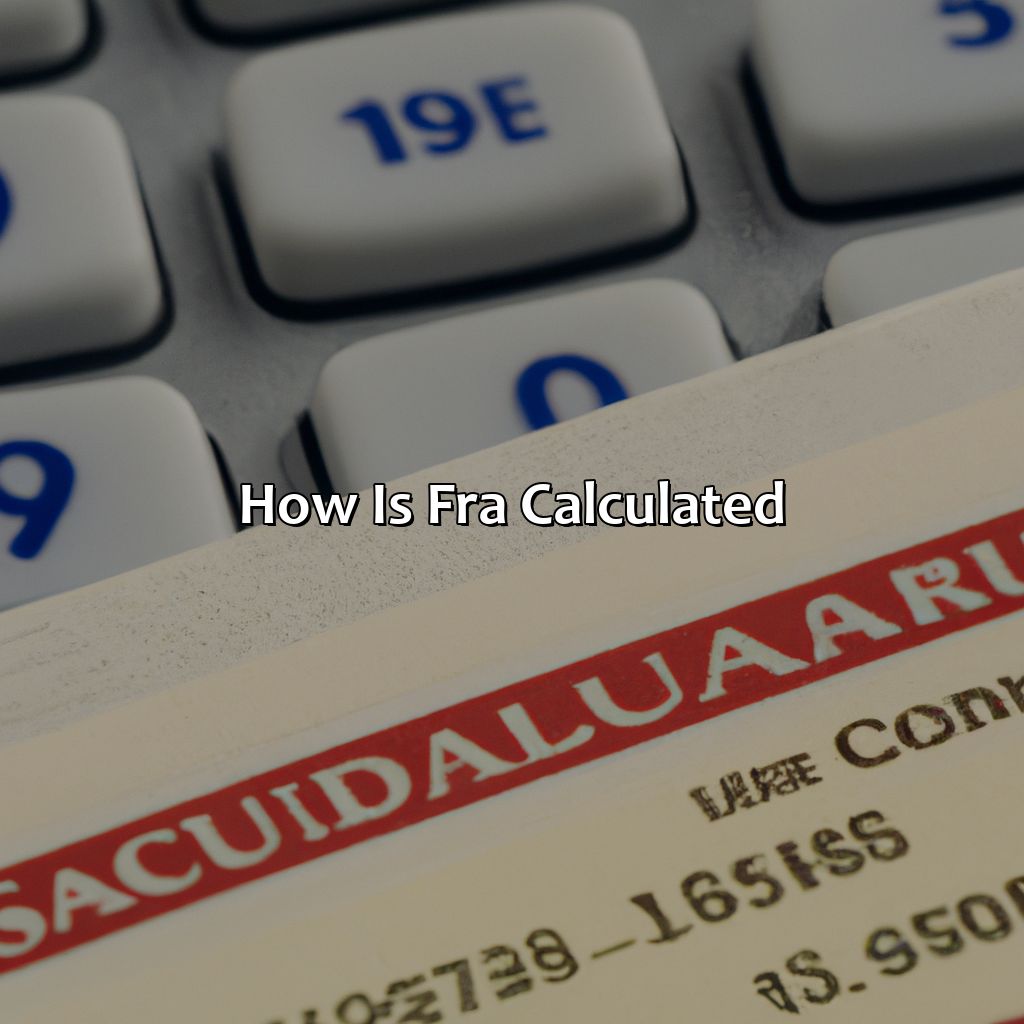What Is Fra In Social Security?
Key Takeaway:
- FRA stands for Full Retirement Age, which is the age at which a person is entitled to receive 100% of their Social Security benefits.
- The FRA is determined by a person’s birth year and can range from age 66 to age 67.
- The calculation of a person’s Social Security benefit at FRA is based on their lifetime average earnings and the highest 35 years of earnings are taken into account. Early retirement reduces benefits and delayed retirement increases benefits.
Are you worried about understanding the complexities of social security? Look no further! This article will provide an overview of FRA or Full Retirement Age, a vital term when it comes to social security. Let’s dive in to learn more about it!
What is FRA?
In Social Security, Full Retirement Age (FRA) refers to the age at which individuals can receive their full retirement benefits. This age varies based on the year individuals were born. Delaying retirement until reaching FRA can result in receiving increased monthly benefits. However, retiring before FRA leads to a reduction in monthly payments. This information is essential for individuals planning for retirement to maximize their Social Security benefits.
To determine your FRA, it is necessary to refer to Social Security Administration’s chart provided, which factors in your birth year. Individuals can start receiving their benefits as early as 62 years old, but it will result in a reduction of up to 30% per month of early claiming. On the other hand, delaying past FRA can result in a monthly increase of up to 8%, increasing the benefits by 24%. Understanding the FRA is crucial since it helps in deciding the appropriate time to claim one’s Social Security benefits.
It is important to note that other factors can affect when one chooses to claim benefits, such as life expectancy, financial stability, and other sources of retirement income. Still, in general, waiting until FRA can lead to a more substantial monthly benefit and help to secure a more comfortable retirement.
A friend of mine once retired early, thinking he could start receiving Social Security benefits at the age of 62 immediately. Unfortunately, he was unaware that claiming before FRA would lead to a substantial reduction in his monthly payments. This resulted in a lower-than-expected monthly income flow throughout his retirement. I encourage you to take your time and do your research to understand the implications of your Social Security retirement benefits fully. You don’t want to make the same mistake my friend did.

Image credits: retiregenz.com by Joel Arnold
FRA Definition
As a critical component of Social Security, the Full Retirement Age (FRA) refers to the point at which an individual can receive their full, unreduced Social Security retirement benefit. This age varies based on the year an individual was born. For example, if someone was born in 1955, their FRA would be 66 years and two months. At this age, an individual can choose to begin receiving their Social Security retirement benefit, which is calculated based on their lifetime earnings.
It is important to note that an individual can begin receiving their retirement benefit as early as age 62, however, the benefit amount will be reduced. Conversely, delaying receiving benefits past FRA may result in an increased monthly benefit amount.
Social Security beneficiaries who work while receiving benefits before FRA may have a portion of their benefits withheld if their earnings exceed certain limits. However, those who work after attaining FRA will not have their benefits reduced, regardless of their earnings. It is crucial for individuals to understand their FRA and the implications of when they begin receiving their Social Security retirement benefit.
One lesser-known aspect of FRA is the ability to file for Social Security benefits based on the earnings of a former spouse, provided the marriage lasted at least ten years. In such cases, the former spouse can receive a benefit amount equal to 50% of the ex-spouse’s full retirement age benefit.
Mary, born in 1961, was planning on retiring at age 62 and was considering starting to receive her Social Security benefits at that time. Her financial planner recommended that she wait until her FRA of 67 to begin receiving her benefits, as it would result in a higher monthly benefit amount. Mary heeded her planner’s advice and was pleased to receive a much higher monthly benefit amount than if she had started receiving benefits at 62.

Image credits: retiregenz.com by Yuval Duncun
How is FRA calculated?
Calculating your Full Retirement Age (FRA) involves certain factors. To know how to do this, you must understand:
- Age-based Calculation
- Early Retirement Reduction
- Delayed Retirement Credit
These subsections provide answers to the formula used to find your FRA for Social Security benefits.

Image credits: retiregenz.com by James Woodhock
Age-based Calculation
The method of calculating Social Security benefits based on age can be explained as the process of FRA determination. This is a complex process that requires careful consideration and understanding of several factors. The age-based calculation involved in determining FRA is an essential part of the process, as it helps to determine how much benefits a person can receive based on their age.
For the Age-based Calculation, there are different columns and criteria that are taken into account, such as eligible birth years, full retirement age, reduction percentage at early retirement, increments for delaying retirement and Delayed Retirement Credits (DRC’s). DRCs add a percentage to your benefit if you delay receiving benefits after your full retirement age until age 70.
The table below represents an example where each row represents birth years from 1943 onwards:
[…]| Birth Year | Full Retirement Age | Reduction % at Early Retirement (age 62) | Credits for Delaying Retirement Before Age 70 |
|---|---|---|---|
| 1943-1954 | 66 | -25/9.00% | +8% |
| 1955 | […] | […] | […] |
| 1960 and later | 67 | -30/6.67% | +8% |
It is important to note that this table is subject to change per SSA updates formulated by Congress.
The amount of social security benefits you may receive depends on your calculated Primary Insurance Amount (PIA), which considers your highest earning years, adjustment for inflation and the age at which benefits are first received, among other factors. Understanding these details is of utmost importance when calculating your FRA.
One fact to consider in this regard is that age-based social security calculations may change over time, affecting the amount of payouts an individual may receive. It is essential to keep up with changes and updates on Social Security Administration websites or through professional consultation.
“Why retire early when you can just work until you drop dead? #RetirementGoals #DarkHumour”
Early Retirement Reduction
The reduction of Social Security benefits due to early retirement is a common concern for many Americans. Payments are reduced by a certain percentage, depending on the recipient’s full retirement age and how soon they claim benefits. The reduction is permanent, but payments increase again at full retirement age.
To calculate the Early Retirement Reduction, the Social Security Administration first determines an individual’s full retirement age based on their birth year. If one claims benefits before this age, the amount will be permanently reduced. The percentage of reduction depends on the number of months between claiming benefits and reaching full retirement age.
It is important to note that the reduction formula may change over time due to amendments in Social Security policies. A professional financial advisor can help individuals navigate the complexities of early retirement planning.
A 55-year-old software engineer named Tom decided to retire early to pursue entrepreneurship. He claimed Social Security benefits at 62 and received a 25% reduction in payments for life. Despite this, he was able to build a successful startup and live comfortably in his retirement years.
Getting older never felt so good – just like a fine wine, your retirement benefits only get better with age thanks to the Delayed Retirement Credit.
Delayed Retirement Credit
The credit that is given to individuals who delay claiming their retirement benefits beyond full retirement age is known as the Benefit Increase After Delayed Retirement credit. This credit can increase an individual’s monthly benefit by up to 8% per year, depending on their year of birth.
To qualify for this credit, individuals must wait until after full retirement age to claim their benefits. Each year that an individual delays claiming benefits, up until age 70, they earn an 8% increase in their monthly benefit. However, once an individual reaches age 70, there is no additional benefit increase for delaying claiming.
It’s important to note that this credit only applies to retirement benefits and does not apply to survivor or disability benefits. Additionally, the increase in benefits due to delayed retirement credits may be subject to income tax.
Don’t miss out on the opportunity to receive a higher monthly benefit by delaying your retirement! Consider speaking with a financial advisor or using the Social Security Administration’s online tools to find out how delayed retirement credits could work for you.
Retirement is like a poker game: Going all in by retiring early or folding until later with delayed retirement can have very different outcomes.
FRA vs. Early or Delayed Retirement
In Social Security, the age at which a beneficiary can receive full retirement benefits is known as the Full Retirement Age (FRA). Here’s how it compares to early or delayed retirement:
- Early Retirement: Beneficiaries can start receiving benefits as early as age 62, but the monthly payment will be reduced.
- Delayed Retirement: Beneficiaries can defer receiving benefits until age 70, and the monthly payment increases with each year of delay.
- Full Retirement Age: Beneficiaries can receive full retirement benefits at their FRA, which varies depending on birth year.
- Choosing the right time: Beneficiaries should consider their personal circumstances before deciding when to start receiving benefits.
- Spousal benefits: Spouses may be eligible for benefits based on their partner’s earnings record, but the timing of their retirement can affect the amount they receive.
It is important to note that the decision on when to start receiving benefits can have a significant impact on a beneficiary’s lifetime benefit amount. It is also important to understand the options available and to plan accordingly.
It is also worth noting that the rules and regulations regarding Social Security benefits are subject to change. Beneficiaries should stay informed about any changes, and consult with a professional advisor if necessary.
To avoid missing out on potential benefits or making a costly mistake, it is crucial for beneficiaries to educate themselves and make an informed decision about retirement timing. Reach out to a professional advisor for help in making the right decision based on your individual circumstances.

Image credits: retiregenz.com by Harry Duncun
Importance of knowing your FRA in Social Security Planning
Knowing your Full Retirement Age (FRA) is crucial in Social Security Planning. It helps individuals understand when they can start receiving their full Social Security benefits and decide if they should delay claiming. Delaying benefits can increase the amount, which is why understanding your FRA is essential.
It is important to note that FRA varies based on the year you were born, and the earliest age to receive benefits is 62. Claiming benefits before FRA can decrease your monthly benefit payments, while delaying beyond FRA can increase them.
Moreover, understanding the implications of receiving benefits early or delaying them is a critical aspect of developing a Social Security plan. Factors such as health, income needs, and financial goals should be taken into consideration when creating a plan.
To maximize Social Security benefits, experts suggest delaying benefits until age 70, as monthly payments increase up to 8% for every year benefits are delayed beyond FRA.
In summary, knowing your FRA is crucial in Social Security planning, and it can help you make informed decisions about when to start receiving benefits. By understanding how age affects your benefit payments, you can maximize your Social Security benefits and secure your financial future.

Image credits: retiregenz.com by Yuval Woodhock
Five Facts About FRA in Social Security:
FRA stands for Full Retirement Age, and it is the age at which individuals can receive 100% of their Social Security benefits. (Source: Social Security Administration)
FRA varies depending on the individual’s birth year, but it ranges between 66 and 67 years old. (Source: Investment News)
Claiming Social Security benefits before FRA can result in reduced benefits, while delaying benefits after FRA can result in increased benefits. (Source: AARP)
Individuals can choose to start receiving Social Security benefits as early as age 62, but their monthly benefits will be permanently reduced. (Source: Social Security Administration)
Working while receiving Social Security benefits may result in reduced benefits if an individual hasn’t reached FRA yet. (Source: Investopedia)
FAQs about What Is Fra In Social Security?
What is FRA in Social Security?
FRA stands for Full Retirement Age. It is the age at which a person can receive their full Social Security retirement benefits.
What is the current FRA for Social Security?
The current FRA for Social Security varies depending on your birth year. If you were born between 1943 and 1954, your FRA is 66. If you were born after 1954, it increases gradually in two-month increments until it reaches 67 for those born in 1960 or later.
Can I receive Social Security benefits before my FRA?
Yes, you can choose to start receiving Social Security retirement benefits as early as age 62. However, your benefits will be reduced if you start receiving them before your FRA.
Can I delay receiving Social Security benefits after my FRA?
Yes, you can delay receiving Social Security retirement benefits until age 70. If you delay receiving benefits after your FRA, your benefit amount will increase by a certain percentage up to age 70.
Does my FRA affect my spouse’s Social Security benefits?
Yes, your FRA can impact your spouse’s Social Security benefits if they are entitled to receive spousal benefits based on your work record. If you delay receiving benefits until after your FRA, your spouse’s benefit amount may also increase.
How can I find out what my FRA is?
You can find out what your FRA is by checking your Social Security statement or by using the Social Security Administration’s online FRA calculator.
 Checkout this IRS Loophole
Checkout this IRS Loophole 
